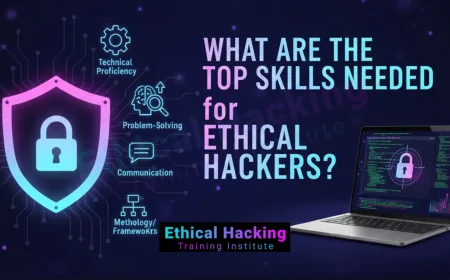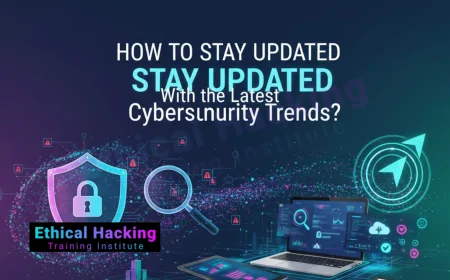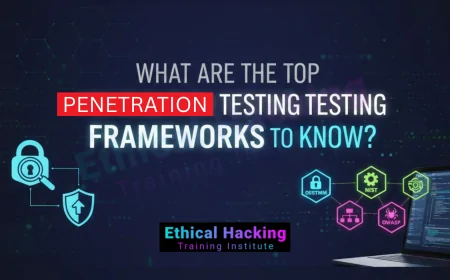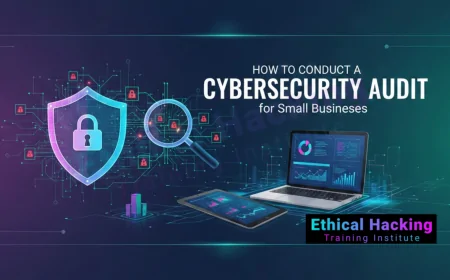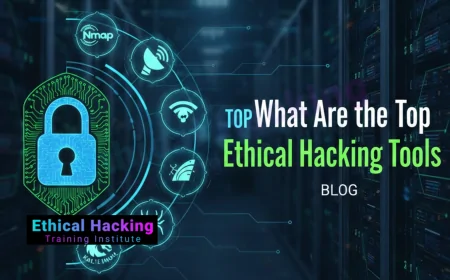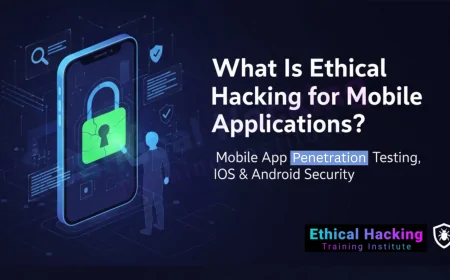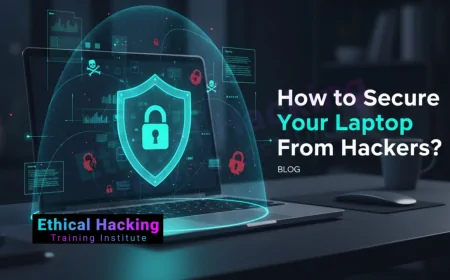CPENT Course Syllabus & Exam Format Explained | Complete Guide to CPENT Certification
Discover the complete CPENT course syllabus and exam format. Learn about the skills, topics, and hands-on labs covered in the CPENT course to help you ace the exam and boost your ethical hacking career. Get ready for success in the CPENT certification!
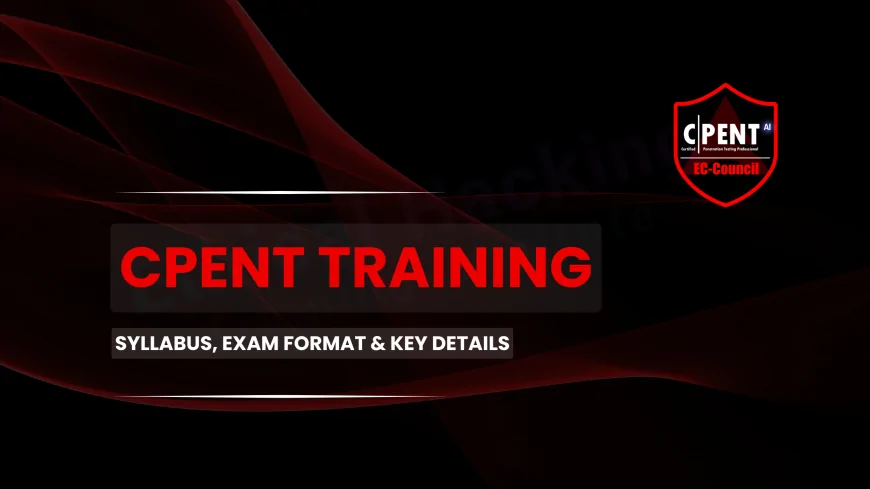
Cybersecurity has evolved far beyond traditional firewalls and antivirus software. In this high-stakes domain, organizations now demand professionals who can not only think like a hacker but also execute advanced penetration tests in complex enterprise environments. This is where the Certified Penetration Testing Professional (CPENT) course shines.
This blog dives deep into the CPENT syllabus and exam format, breaking down each domain, module, and test segment to help aspirants understand what it takes to earn one of the most challenging and prestigious ethical hacking certifications available today.
What is the CPENT Certification?
The CPENT (Certified Penetration Testing Professional) is an advanced-level ethical hacking certification designed to test the skills of cybersecurity professionals in real-world, performance-based penetration testing scenarios. Unlike traditional certifications that rely heavily on multiple-choice questions, CPENT is entirely hands-on and examines candidates on live cyber ranges.
This certification is ideal for those who want to:
-
Become professional penetration testers
-
Master advanced ethical hacking skills
-
Simulate complex attack chains in enterprise systems
-
Learn beyond standard red teaming strategies
-
Challenge themselves under time-pressured conditions
Who Should Take the CPENT Course?
The CPENT certification is designed for:
-
Ethical hackers and penetration testers
-
Red team professionals
-
Security consultants
-
Cybersecurity analysts and incident responders
-
IT administrators with advanced network security experience
-
Anyone preparing for leadership roles in offensive security
Prerequisites typically include a solid foundation in ethical hacking (CEH-level), knowledge of Linux and Windows environments, and intermediate-level scripting and networking skills.
Overview of the CPENT Syllabus
The CPENT syllabus is a carefully structured set of modules that reflect real-world attack vectors, enterprise systems, and emerging technologies. The course content emphasizes hands-on practical skills, focusing on offensive tactics, pivoting, evasion, privilege escalation, and exploitation.
Let’s break down the CPENT syllabus into key modules:
1. Enterprise Network Penetration Testing
This module dives into testing large-scale, segmented networks typical of enterprise environments.
Topics include:
-
Understanding internal segmentation and firewall rules
-
Reconnaissance on internal hosts
-
Exploitation techniques across VLANs
-
Traffic sniffing and MITM attacks in segmented networks
-
Building and maintaining covert channels
2. Web Application Penetration Testing
Web-based threats are a major concern, making this a critical module in the syllabus.
Topics include:
-
SQL injection (manual and automated)
-
Cross-site scripting (XSS)
-
File upload attacks
-
Session management flaws
-
Web shell exploitation
-
Server-side request forgery (SSRF)
-
Business logic attacks
-
Directory traversal and authentication bypass
3. Wireless Penetration Testing
Wireless networks are a weak link in many infrastructures. This module teaches how to assess and exploit them.
Key areas:
-
Cracking WPA2 using dictionary attacks
-
Evil twin attacks
-
Rogue access point setup
-
Wireless sniffing and session hijacking
-
Wireless credential harvesting
4. IoT Device Exploitation
Internet of Things (IoT) security is rapidly growing in importance. CPENT includes this cutting-edge area.
Focus areas:
-
Firmware analysis and extraction
-
UART and JTAG exploitation
-
Reverse engineering binaries
-
Attacking smart devices
-
Buffer overflow on embedded systems
5. Binary Exploitation
Candidates must demonstrate low-level exploitation techniques in a controlled lab environment.
Skills tested:
-
Stack-based buffer overflows
-
SEH exploitation
-
Writing and modifying shellcode
-
Bypassing ASLR and DEP
-
Return-oriented programming (ROP)
6. Privilege Escalation
Privilege escalation is a critical post-exploitation tactic.
Topics covered:
-
Enumeration of users, services, and processes
-
Kernel exploitation
-
DLL hijacking
-
Sudo misconfigurations (Linux)
-
Registry and task-based escalation (Windows)
7. Active Directory Attacks
The CPENT syllabus covers advanced exploitation of AD environments, a staple in enterprise networks.
Key areas:
-
Kerberos attacks (Pass-the-Ticket, Golden Ticket)
-
Lateral movement using PsExec
-
BloodHound for privilege escalation mapping
-
Group policy object manipulation
-
Exploiting trust relationships between forests
8. Social Engineering
Though brief, this module highlights phishing and social engineering attacks as a part of penetration testing.
Skills include:
-
Creating and launching phishing campaigns
-
Payload generation
-
Email spoofing
-
Credential harvesting through cloned login pages
9. Evading Defenses
Candidates learn to bypass modern detection tools such as firewalls, EDRs, and antivirus systems.
Topics include:
-
Obfuscating payloads
-
Custom malware generation
-
Encoding and encryption techniques
-
Process injection
-
Living-off-the-land binaries (LOLBins)
10. Report Writing and Documentation
Proper reporting is critical in professional penetration testing.
Focus areas:
-
Structuring executive and technical summaries
-
Risk scoring and mitigation suggestions
-
Detailing exploitation steps with screenshots
-
Compliance mapping (e.g., to OWASP or MITRE ATT&CK)
CPENT Exam Format Explained
The CPENT exam is not a traditional multiple-choice certification. It is a completely hands-on, 24-hour practical exam conducted in a controlled online lab environment.
Here’s what makes the CPENT exam unique:
24-Hour Practical Lab Exam
The CPENT exam is split into two 12-hour sessions or a single 24-hour session (based on candidate preference). You must compromise a set of live machines in a simulated network with enterprise-like systems.
Score-Based Certification Levels
-
CPENT Certification: Score between 70% and 89.9%
-
LPT Master Certification: Score 90% or more
Both levels are awarded based on the same exam, but the level depends on your final score. This is what makes CPENT a dual-certification opportunity.
What’s Tested in the Exam?
You are assessed on:
-
Enumeration, exploitation, post-exploitation
-
Advanced pivoting
-
Web, wireless, and IoT penetration
-
Writing custom exploits
-
Bypassing firewalls and antivirus
-
Documentation and report writing
Live Cyber Range Setup
Candidates are dropped into a virtual network range containing firewalls, Linux and Windows machines, vulnerable applications, and custom binaries. You must navigate and exploit these in sequence to gain maximum points.
Exam Structure Breakdown
| Section | Weightage |
|---|---|
| Web Application Exploitation | 10% |
| Network & System Exploitation | 20% |
| Binary Exploitation | 15% |
| IoT & Wireless Attacks | 10% |
| Active Directory Exploitation | 15% |
| Privilege Escalation | 10% |
| Advanced Defense Evasion | 10% |
| Pivoting and Lateral Movement | 5% |
| Report Writing | 5% |
Exam Submission Format
Candidates must:
-
Submit screenshots and proof files
-
Submit a full professional penetration testing report
-
Follow naming and evidence instructions strictly
Tools and Skills You’ll Use in CPENT
A candidate must be proficient with tools like:
-
Nmap, Metasploit, Burp Suite
-
Wireshark, Aircrack-ng
-
Hydra, Netcat, John the Ripper
-
Mimikatz, BloodHound
-
Custom scripts in Python, PowerShell, or Bash
-
Debuggers (Immunity, OllyDbg, GDB)
What Makes CPENT Unique?
-
Live, immersive lab testing: It’s not theoretical. You have to prove your skills in real time.
-
Dual-certification potential: The same exam lets you earn both CPENT and LPT Master, based on performance.
-
Enterprise-level challenges: Simulates real networks, not isolated machines.
-
IoT and binary exploitation coverage: Goes beyond what most pentesting certs offer.
-
Focus on documentation: Tests your ability to report findings professionally.
CPENT vs Other Certifications
| Feature | CPENT | OSCP | CEH |
|---|---|---|---|
| Practical Exam | Yes (100% practical) | Yes (100% practical) | No (MCQ format) |
| Dual Certification | Yes (CPENT & LPT) | No | No |
| Binary Exploits | Included | Limited | Not included |
| IoT/Wireless Attacks | Included | Limited | Not included |
| AD Exploitation | Strong Coverage | Moderate | Light Introduction |
| Focus on Reporting | Strong | Moderate | Weak |
Tips to Prepare for the CPENT Exam
-
Master your basics: Be confident with Linux, Windows, networking, and scripting.
-
Practice in a lab: Set up your home lab or use online labs to simulate CPENT-style networks.
-
Learn to pivot: Multi-layered pivoting is key to exam success.
-
Don’t ignore report writing: Practice clear, concise, and technical reporting.
-
Time management: Practice timed exams to simulate the 24-hour challenge.
FAQ's
1. What is the CPENT course syllabus?
The CPENT course syllabus includes topics like network penetration testing, web application security, exploitation techniques, privilege escalation, cryptography, and post-exploitation. The course prepares you for the CPENT certification exam, covering both theoretical knowledge and hands-on lab work.
2. How long is the CPENT training course?
CPENT training typically lasts 6 to 8 weeks, depending on the training institute and course format. This duration includes both theoretical classes and practical labs, ensuring thorough preparation for the CPENT exam.
3. What are the prerequisites for CPENT certification?
CPENT certification is designed for individuals with a basic understanding of ethical hacking and networking. Knowledge of tools like Nmap, Metasploit, and basic programming is beneficial but not mandatory. A background in cybersecurity or penetration testing is ideal.
4. Does the CPENT course in Pune include hands-on labs?
Yes, CPENT courses in Pune emphasize hands-on labs. Students practice real-world penetration testing scenarios using specialized tools and techniques to test their skills. These labs are designed to simulate real hacking environments, enhancing practical learning.
5. How do I register for the CPENT exam?
Registration for the CPENT exam can be done through the official EC-Council website. You’ll need to create an account, choose your preferred exam location, and schedule the exam. The exam is available both online and in designated test centers.
6. What is the format of the CPENT exam?
The CPENT exam consists of practical and theory-based assessments. It includes hands-on penetration testing labs that must be completed within a set time, along with a report submission. The practical portion tests real-time hacking skills.
7. How difficult is the CPENT exam?
The CPENT exam is considered challenging due to its practical nature. It tests real-world hacking skills, including penetration testing, network exploitation, and post-exploitation activities. Preparing through hands-on labs and mock exams can help increase your chances of success.
8. What skills will I learn in the CPENT course?
In the CPENT course, you will learn network penetration testing, vulnerability assessment, web application attacks, buffer overflows, privilege escalation, cryptography, and reporting. These skills are vital for a career in ethical hacking and penetration testing.
9. Does the CPENT course offer certification upon completion?
Yes, upon successfully completing the CPENT course and passing the exam, you receive the Certified Professional Ethical Hacker (CPENT) certification. This globally recognized certification is valuable for career advancement in cybersecurity.
10. Can CPENT help in transitioning to a penetration testing career?
Yes, CPENT is designed to provide the knowledge and skills required to become a proficient penetration tester. The course covers all aspects of ethical hacking, preparing you for real-world challenges and job roles in penetration testing.
11. What is included in the CPENT exam report?
The CPENT exam includes a practical hacking lab where you must complete penetration tests and submit a comprehensive report. The report should detail the vulnerabilities discovered, exploitation methods used, and remediation advice, similar to how professional penetration testers report their findings.
12. How is the CPENT certification different from CEH?
The CPENT certification focuses more on practical penetration testing skills, including hands-on labs and real-world scenarios. In contrast, CEH (Certified Ethical Hacker) is more theory-oriented and focuses on general ethical hacking knowledge. CPENT is more advanced and hands-on.
13. What tools are taught in the CPENT course?
The CPENT course includes tools like Nmap, Burp Suite, Metasploit, Nikto, Hydra, and Wireshark. These tools are essential for network scanning, vulnerability assessment, and exploitation. The course teaches you how to use these tools effectively in penetration testing.
14. Are there mock exams available for CPENT preparation?
Yes, most Ethical Hacking Training Institutes in Pune offer mock exams to help you prepare for the CPENT exam. These mock exams simulate the actual test environment and help you assess your knowledge and practical skills.
15. How much does the CPENT course cost in Pune?
The CPENT course in Pune typically costs between ₹40,000 and ₹80,000, depending on the training institute, course materials, and duration. Some institutes offer payment plans or discounts, so it's best to check with individual providers.
16. How can CPENT certification enhance my career?
CPENT certification demonstrates your proficiency in penetration testing, making you more attractive to employers in cybersecurity. It opens up career opportunities in ethical hacking, network security, and penetration testing roles, often leading to higher salaries and career growth.
17. Does CPENT include web application security training?
Yes, web application security is an integral part of the CPENT course syllabus. You will learn how to perform penetration tests on web applications, including SQL injection, cross-site scripting (XSS), and other common web vulnerabilities.
18. Can I take the CPENT exam online?
Yes, the CPENT exam is available online through EC-Council’s official platform. You will need a stable internet connection and a computer equipped with specific software requirements. The exam is conducted in a virtual environment.
19. What is the passing score for the CPENT exam?
To pass the CPENT exam, you must score at least 70% on the practical exam and submit the required report. The practical portion carries the most weight in the final score, as it evaluates your real-time penetration testing skills.
20. How can I prepare for the CPENT exam in Pune?
You can prepare for the CPENT exam by enrolling in an Ethical Hacking Training Institute in Pune that offers hands-on training, lab work, and mock exams. Consistent practice on penetration testing tools, real-world scenarios, and post-exploitation techniques is essential.
21. Is there any additional material provided in the CPENT course?
Yes, most CPENT training programs include additional study materials such as eBooks, lab exercises, video tutorials, and practice exams. These materials help reinforce learning and ensure that students are fully prepared for the exam.
22. How does CPENT compare to other ethical hacking certifications?
CPENT is more focused on practical penetration testing and hands-on experience compared to other certifications like CEH or OSCP. CPENT is ideal for those looking to specialize in penetration testing, offering a deeper dive into real-world exploitation techniques.
23. How are the labs structured in CPENT?
CPENT labs are structured to simulate real-world penetration testing scenarios. You will be tasked with identifying vulnerabilities, exploiting them, escalating privileges, and documenting your findings in a professional report, all while working under time constraints.
24. What job roles can I pursue with a CPENT certification?
After earning the CPENT certification, you can pursue roles such as Penetration Tester, Ethical Hacker, Vulnerability Assessor, Security Consultant, and Incident Responder. CPENT is particularly valuable for penetration testing and red team roles.
25. Can CPENT be taken after CEH certification?
Yes, CPENT is a great follow-up to the CEH certification. While CEH provides foundational ethical hacking knowledge, CPENT takes your skills to the next level by focusing on real-world penetration testing techniques and advanced exploitation strategies.
Final Thoughts: Is CPENT Worth It?
If you're serious about advanced penetration testing and want a certification that proves your ability to think, act, and report like a real-world attacker, CPENT is one of the best paths forward.
It goes beyond conventional training by challenging your creativity, adaptability, and ability to deliver results under pressure. Whether you're aiming for career growth, high-end freelance gigs, or advanced security roles, mastering the CPENT syllabus and passing its intense exam will put you in elite company.
What's Your Reaction?
 Like
0
Like
0
 Dislike
0
Dislike
0
 Love
0
Love
0
 Funny
0
Funny
0
 Angry
0
Angry
0
 Sad
0
Sad
0
 Wow
0
Wow
0
